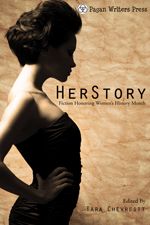
Coming from Pagan Writers Press on March 8, 2013!
Search
Powered by Blogger.
Tribe
Contributor's Blogs
Friday, March 29, 2013
Meeting Ela by Dorothy Abrams
12:00 AM
| Posted by
Tara

When Eric and I travel, magical things happen. One of them was meeting Ela of Salisbury in 2010. Of course she had been dead since 1260, but we never let a small consideration like that interfere with our adventures. When we visited Salisbury Cathedral in June 2010, I had never heard of Ela of Salisbury. I vaguely knew of her husband William Longspee, son of Henry II. Unaware of what was about to happen, we walked into the apse from the hot sun, grateful for the cool interior and a chance to sit down. The next cathedral tour was nearly an hour away. We were undecided whether to rest for a long time or wander around on our own once we found our second wind.

A group of senior citizens, tour guides for the cathedral, were discussing the day's work. A particularly tall and distinguished gentleman walked over to us and introduced himself as Roger. He said it was time for the next tour. Would we come with him? Eric hushed me when I foolishly tried to protest that it was not at all the right time. Sometimes I can be dense. What followed was a two-hour personal exploration of a great cathedral and its history, guided by a wise and knowledgeable man who knew all the secrets and untold treasures of Salisbury. If I didn't know his name was Roger, I would have thought it was William of the long spear.
I learned that Salisbury Cathedral was built rapidly between 1220 and 1258 under the auspices of Bishop Richard Poore and Ela and William Longspee, son of Henry II and half-brother to King Richard and King John. The bishop laid the cathedral cornerstone. The Count and Countess laid the 4th and 5th foundation stones. The land came from the bishop. Much of the money came from the Ela and William. I also learned that Ela had been orphaned early and subsequently married to protect her as much as for any other reason when she was 9. The young man who took her as his wife was in his mid 20's. Typically such men agreed not to consummate a marriage before the bride could conceive children, a private matter which of course is not recorded. The practice was common among the greater nobles.
Nevertheless, William and Ela loved one another. According to Roger, William was known as Longspee because of his height and long reach with a spear. He was a warrior of great ability. He commanded the fleet and some armies for his brothers, frequently being delayed and occasionally captured or shipwreck in his efforts to get back home. Despite political maneuverings against him to get his money and his wife, Ela always believed he would return. She waited faithfully and would not heed the politicians who assured her she was widowed in hopes of marrying her. As Roger spoke, Ela came alive in my mind. I wanted to know more.

Eventually of course, lovers do die. Roger said that William had been commander of the fleet on an expedition to Gascony on the Continent in 1225. He was shipwrecked in a storm and given up for dead. The young king's regent Hugh de Burgh tried to convince Ela to marry again, but she refused. When her husband returned, he confronted de Burgh who was all smiles and apologies to his friend over dinner. William returned from dinner ill. He failed quickly and was dead to the horror of his family.
Roger explained that although the Magna Carta of 1215 guaranteed women the right not to be married against their will, it was a new guarantee. Ela had little confidence in the law since de Burgh was the law. Instead of leaving her fate to chance, she quickly allied herself with the Church and set about founding a monastery and an abbey in Wiltshire in memory of her husband. After seeing the tomb of William Longspee in Salisbury we were encouraged to journey to Lacock Abbey founded by Ela of Salisbury in 1229. My first reaction to a woman giving up secular life to become a nun was less than enthusiastic. Surely there was another way? I have never been a friend of the cloistered life nor the church. Still, off to Lacock we went.
Again, it was a long walk on a hot day from the entrance to the Abbey. The roses were magnificent. The shade sparse. I was a little cranky by the time I entered the Abbey door.
 Immediately I felt the peace that Ela lived with. Inside those walls was serenity. Spirituality. Centeredness and grounding. This was what Ela wanted. This is what she created. I gazed lovingly at her arches and corridors. I walked in her rooms, imagining my steps fit hers. I heard her whispers in my ear. I turned to Eric and said "I want one of these." He laughed at me. A Norman abbey would look strange in Upstate NY. I could feel Ela's hand in everything within the cloisters of Lacock. Roger admired Ela's ingenuity in ordering her own life to escape an unwanted marriage, but it was more than escape. Ela created a place for her presence. Ela lived at Lacock from 1238-1257. She is buried there with the heart of her husband. Except of course I met her in 2010, and maybe I met her husband.
Immediately I felt the peace that Ela lived with. Inside those walls was serenity. Spirituality. Centeredness and grounding. This was what Ela wanted. This is what she created. I gazed lovingly at her arches and corridors. I walked in her rooms, imagining my steps fit hers. I heard her whispers in my ear. I turned to Eric and said "I want one of these." He laughed at me. A Norman abbey would look strange in Upstate NY. I could feel Ela's hand in everything within the cloisters of Lacock. Roger admired Ela's ingenuity in ordering her own life to escape an unwanted marriage, but it was more than escape. Ela created a place for her presence. Ela lived at Lacock from 1238-1257. She is buried there with the heart of her husband. Except of course I met her in 2010, and maybe I met her husband.
***
Subscribe to:
Post Comments
(Atom)




Very interesting! Thanks so much for sharing:)
ReplyDelete